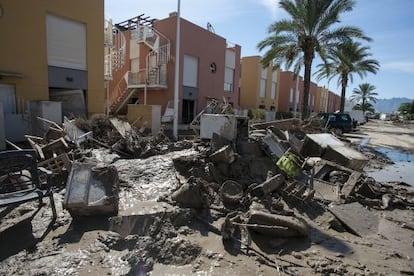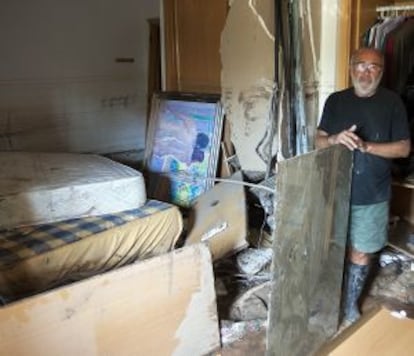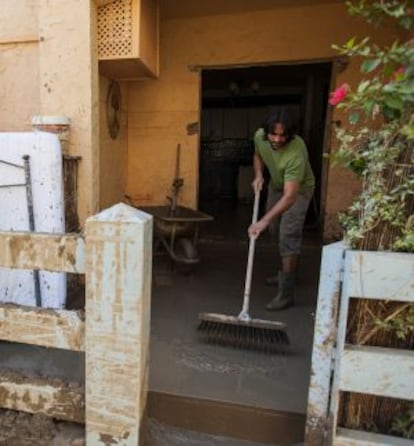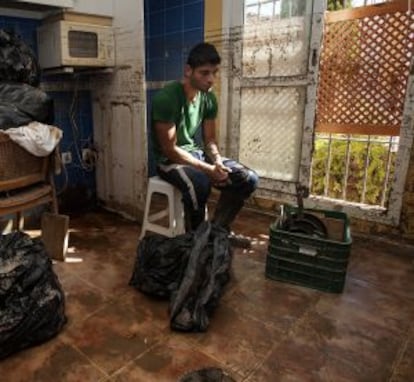You are now entering Disaster Avenue
Everyone knew Juan Sebastián Elcano street in Vera, Almería, was prone to flooding. It was built alongside the River Antas, which burst its banks in 1973 and 1989

Let us go back to that moment just after 11am on Friday, September 28. A few minutes earlier, the local police had slowly driven down Juan Sebastián Elcano street in the Andalusian town of Vera in Almería province asking residents to take their parked cars elsewhere. But it was pretty useless. Many people who live here are foreigners who don't understand Spanish very well; others thought the message, delivered through a loudspeaker, came from one of the countless street vendors in town; yet others didn't hear a thing. In any case, practically nobody heeded the warning.
At that time of day, just after 11am, when the rain was still not coming down hard enough to scare anybody, a retired man named Alfonso Hidalgo Moreno who had just taken his dogs Bobo and Betis out for their walk was making coffee in his kitchen; the lifeguard Antonio González, 33, was sending a text message to a friend as he watched TV; Karin Radomsky, a 58-year-old woman from Germany, stopped putting away the groceries and started moving clothes and furniture up to the first floor, because she and her family could feel that something horrible was about to happen; Raquel, a 65-year-old lady who was making a lentil stew, heard a car honking outside and a driver yelling desperately: "Water coming! Water coming!"
This is what all these people said they were doing moments before the water poured into their homes. Over 200 liters of rainfall per square meter were registered in the mountains. The water of the River Antas, which is normally dry throughout the year, found its old riverbed as it made its way out to sea and destroyed everything in its path. In a little over 10 minutes, it made a quagmire of Juan Sebastián Elcano street, located near the mouth of the river, where several holiday and retirement estates were built decades ago. The torrent shattered glass, ripped down walls, overturned cars, and washed out to sea the life savings and the future plans of many people, even killing a 52-year-old woman right there on that very street.
The floods damaged 4,300 homes and 130 businesses and swept away 1,000 vehicles
According to the preliminary damage report released by Vera city officials, the flooding affected around 85 hectares of land on both sides of the river mouth. In total, 4,300 homes, 130 business premises and 1,950 parking places sustained damage; besides that, around 1,000 vehicles were dragged away by the current.
"I'm left with nothing," says Alfonso Hidalgo as he shows pictures from a muddy photo album outside his house. The flood tide destroyed his front door and a wall. Alfonso recalls standing almost up to his waist in water and taking refuge upstairs. He was rescued in the afternoon and taken to a local pavilion with hundreds of other people. When he returned home the next day, he managed to recover one important thing: a dental prosthesis that he'd lost in the mud. "I live on very little money. I'm retired and I came to live here on my savings. If I'd lost the prosthesis, I couldn't have afforded another one. All I have left is what I'm wearing right now," he says, his voice tight and on the edge of tears.
Momo, a Czech man who works as a go-go dancer at Almería nightclubs, stares down at the floor as he sits on a chair, surrounded by useless muddy objects. Alfonso had been able to rescue his dogs, but not Momo. His rottweiler Daisy was carried away by the flood. Before losing her, he was able to rescue an elderly woman by forcing the door of her house open.
I asked the mayor how houses were allowed to go up here in the first place"
A few meters down from here, Antonio González, the lifeguard, laments that he will have to return to Madrid. "I liked life here, but there's nothing left. It's over. I'll have to go back and look for a job elsewhere. Although at this point there are no jobs anywhere."
Raquel, the woman who was preparing lentils, remembers feeling surprised when she saw herself putting the stew pot on a shelf after it started floating in the water. "As though that could help," she says.

Juan Sebastián Elcano street is a long two-lane avenue that provides access to the beach and runs parallel to the mouth of the River Antas. It is one of the few streets in the area supporting retail business. Besides the estates containing hundreds of apartments, there are four bars, a supermarket, two beauty centers, a swimming pool, tennis courts, a roast chicken take-out, an erotica store, an automatic teller machine, an architect studio and seven real estate agencies, most of which shut down after the property bubble burst.
The first residential developments in the area were planned in the late 1970s. In 1982, the city reclassified the land where Juan Sebastián Elcano street now stands as fit for building. That was when the first foreigners started showing up, mostly British, Italian, Norwegian, German and Austrian, who bought time-share properties. "But the greatest development push began in 1995," says Karin Radomsky, who has been familiar with this area since 1989.
The magnitude of the drama is plain to see these days, and it is hard to imagine what this street looked like before the flooding. The homeowners are attempting to get the mud out of their homes, but the thick, dark paste has obstructed every opening. In many houses, a black line shows how high the water rose: 2.80 meters. Outside, the sidewalk is a dumpsite where furniture and appliances pile up. There are refrigerators nesting on the treetops and cars stuck in the most unlikely places. There are also groups of foreigners helping with the cleanup work for a few euros. Rain boots are sold out in all the nearby towns.
Residents are now starting to ask themselves questions. Those who lost their assets are turning against the authorities and seeking for those responsible. But for now, nobody is stepping up to take the blame.

"I asked the mayor how buildings were ever allowed to go up here in the first place. Nature has no way out," says Luis Antonio Petit, an advertising professional who lives in Madrid and has a second residence in Playas del Sur, a development where 170 homes were destroyed. He also points to the lack of maintenance work along the riverbed, which residents had demanded in the past.
In any case, everyone knew that Pueblo Laguna, the area where Juan Sebastián Elcano street is located, and Puerto Rey, both on the mouth of the river, had been flooded in the past. In 1973, the flood also hit other villages and there were hundreds of victims up and down the coast. There were more cases after that, although perhaps 1989 is the year that residents remember best.
"I've been in this situation before. What you see me doing now, I did back then," says an Englishman who is trying to get the mud out of his restaurant.
Various officials provide various answers as to what caused the flooding. The city says the lack of proper riverbed maintenance is to blame. "We begged the government of Andalusia to clear the riverbed of shrubs and reeds and to channel it," says Mayor José Carmelo Jorge Blanco, of the Popular Party, who has been on the job for a year and a half. Before that, the city was run by the regionalist Partido Andalucista.

He also says that this is not the time to assign blame. "We are stretched to the limit. We need help to ensure that people who live here do not suffer from flooding any more."
The government of Andalusia says that in August 2008 it authorized the city of Vera to clean up the riverbed, but that the latter did not do so for financial reasons. It also admits to vetoing one local project because it was allegedly linked to a real estate operation that involved diverting a riverbed "with the sole aim of freeing up land prone to flooding and building new developments there," reads an October 3 report by the regional department of agriculture, fishing and the environment. The Junta says it has only been allowed to strike down local building plans since 1994, when the Andalusia Environmental Protection Law was passed. "Puerto Laguna and Puerto Rey were built in the mid-70s. The developers were able to build the homes with nothing more than a municipal license," said a regional government spokesman.
"Officials at all levels have a share of responsibility in this, and also a few owners who fiercely opposed a demarcation plan for Playa Vera that would have declared the area prone to flooding," says Miguel Ángel Losada, a professor of hydraulic engineering at Granada University. This expert wrote a report that was very critical of the government's new Coast Law, which will pardon thousands of homes built illegally right on the shoreline. One of the examples he used in this report is Playa Vera, as though he had had a premonition of what was about to happen.
"Protecting Playa Vera can cost five million euros. The new reform takes the cost of flood cleanups out of the state budget. But who must pay for it? It should be the people who built in those areas. If we put residential estates and roads next to riverbeds and sea banks, we will see more disasters like Playa Vera. It's madness," says Losada.
The city says the cause is the lack of proper riverbed maintenance
A voice on the other end of the line says: "You have reached the Consortium of Insurance Compensation." This is the reply that victims of the flooding keep getting when they call. After that, they have to wait 72 hours for someone from the state-owned company to come take a look at the damage and take charge of the situation.
"They tell you not to touch anything," says one of the victims inside a bar called La Cala, where a group of people are eating some sandwiches as they try to come to terms with what has happened to them. They are tired, and their faces show the indignation of people who have spent hours standing in the mud. "I think we haven't received the kind of emotional support we should have. We've been left alone," continues the woman. "There weren't even a few free sandwiches or drinking water for those of us who have been cleaning up. I didn't see images of this like I saw images of the oil spill in Galicia [the Prestige oil spill of 2002], and the media in general has not paid too much attention to what's happened here."
Near Juan Sebastián Elcano street, the cleanup crews carry on with their work. The mud is piling up on the sidewalks. Some houses they leave alone - they belong to foreigners who have not made it here yet, or else they were foreclosed by the banks. The smell is starting to get stronger. Cristóbal, a man who would rather not give his surname, is looking for a plasma television set that he left on a pile with all his other belongings. But it's not there anymore. There's been talk of pillaging in the last few days, of groups that roam the streets looking for something to take.
"I don't know who might want that, it's useless by now," says Cristóbal, who wants the whole area to be expropriated, owners compensated and no more housing built here by the river mouth ever again.
Tu suscripción se está usando en otro dispositivo
¿Quieres añadir otro usuario a tu suscripción?
Si continúas leyendo en este dispositivo, no se podrá leer en el otro.
FlechaTu suscripción se está usando en otro dispositivo y solo puedes acceder a EL PAÍS desde un dispositivo a la vez.
Si quieres compartir tu cuenta, cambia tu suscripción a la modalidad Premium, así podrás añadir otro usuario. Cada uno accederá con su propia cuenta de email, lo que os permitirá personalizar vuestra experiencia en EL PAÍS.
¿Tienes una suscripción de empresa? Accede aquí para contratar más cuentas.
En el caso de no saber quién está usando tu cuenta, te recomendamos cambiar tu contraseña aquí.
Si decides continuar compartiendo tu cuenta, este mensaje se mostrará en tu dispositivo y en el de la otra persona que está usando tu cuenta de forma indefinida, afectando a tu experiencia de lectura. Puedes consultar aquí los términos y condiciones de la suscripción digital.
Últimas noticias
Pinochet’s victims grapple with José Antonio Kast’s rise in Chile
Reinhard Genzel, Nobel laureate in physics: ‘One-minute videos will never give you the truth’
From digital curfews to blocking apps: How technology experts protect their children online
Why the price of coffee has skyrocketed: from Brazilian plantations to specialty coffee houses
Most viewed
- Pablo Escobar’s hippos: A serious environmental problem, 40 years on
- Why we lost the habit of sleeping in two segments and how that changed our sense of time
- Trump’s obsession with putting his name on everything is unprecedented in the United States
- Charles Dubouloz, mountaineering star, retires at 36 with a farewell tour inspired by Walter Bonatti
- The Florida Keys tourist paradise is besieged by immigration agents: ‘We’ve never seen anything like this’








































